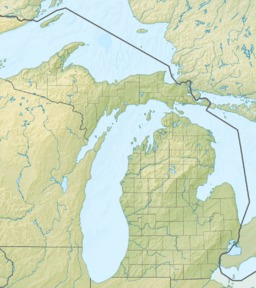Grand Lake (Michigan) facts for kids
Quick facts for kids Grand Lake |
|
|---|---|
| Location | Presque Isle County, Michigan |
| Coordinates | 45°18.14′N 83°29.76′W / 45.30233°N 83.49600°W |
| Basin countries | United States |
| Surface area | 5,660 acres (22.9 km2) |
| Surface elevation | 594 feet (181 m) |
Grand Lake is a really cool lake in Michigan, a state in the United States. It's located in Presque Isle County. This big lake covers about 5,660 acres (22.9 km²). It's about 7 miles (11 km) long and up to 1.5 miles (2.5 km) wide.
The lake sits between Presque Isle Township on the east and Krakow Township on the west. You can find it about 15 miles (25 km) north of Alpena. U.S. Highway 23 passes by the south and west sides of the lake.
Contents
Grand Lake: A Cool Michigan Spot
Where is Grand Lake?
Grand Lake is found in Presque Isle County, in the state of Michigan. It's a large body of water, covering over 5,600 acres. That's like more than 4,000 football fields! The lake is quite long, stretching about 7 miles (11 km). It's also pretty wide, up to 1.5 miles (2.5 km) across.
What Lives in the Lake?
Grand Lake is a great place for fishing! Many different kinds of fish call this lake home. You might find bluegill, bullhead catfish, and northern pike. Other fish include garpike, bowfin, and pumpkinseed sunfish. You can also catch rock bass, smallmouth bass, white sucker, yellow perch, and walleye.
Islands and Lighthouses
Grand Lake is special because it's near a piece of land that sticks out into Lake Huron. This land is almost like an island, which is why the area is called "Presque Isle." "Presque Isle" means "almost an island" in French!
The lake itself has many islands. Some of these include Brown Island, Grand Island, and Macombers Island.
Close to the lake, on the east side, are two famous lighthouses. These are the New Presque Isle Lighthouse and the Old Presque Isle Lighthouse. They are important landmarks in the area.
Ancient Discoveries
Scientists have found interesting things deep below Grand Lake. They discovered deposits of rock salt about 1,284 feet (391 meters) down.
On the west shore of the lake, there are ledges that rise about 40 feet (12 meters) above the water. These ledges hold ancient secrets! You can find fossils of creatures like Cerepatora and parts of crinoids there. Crinoids are also known as "sea lilies" and are related to starfish.


